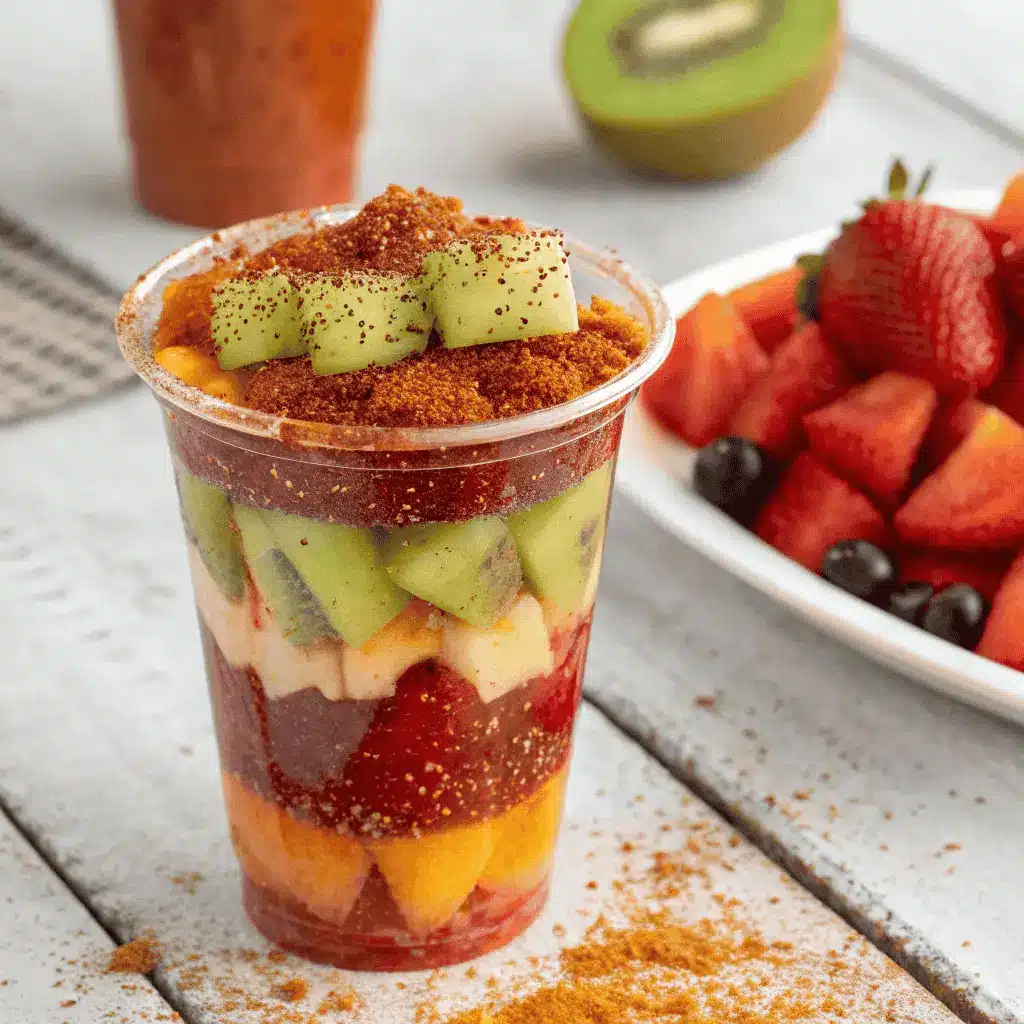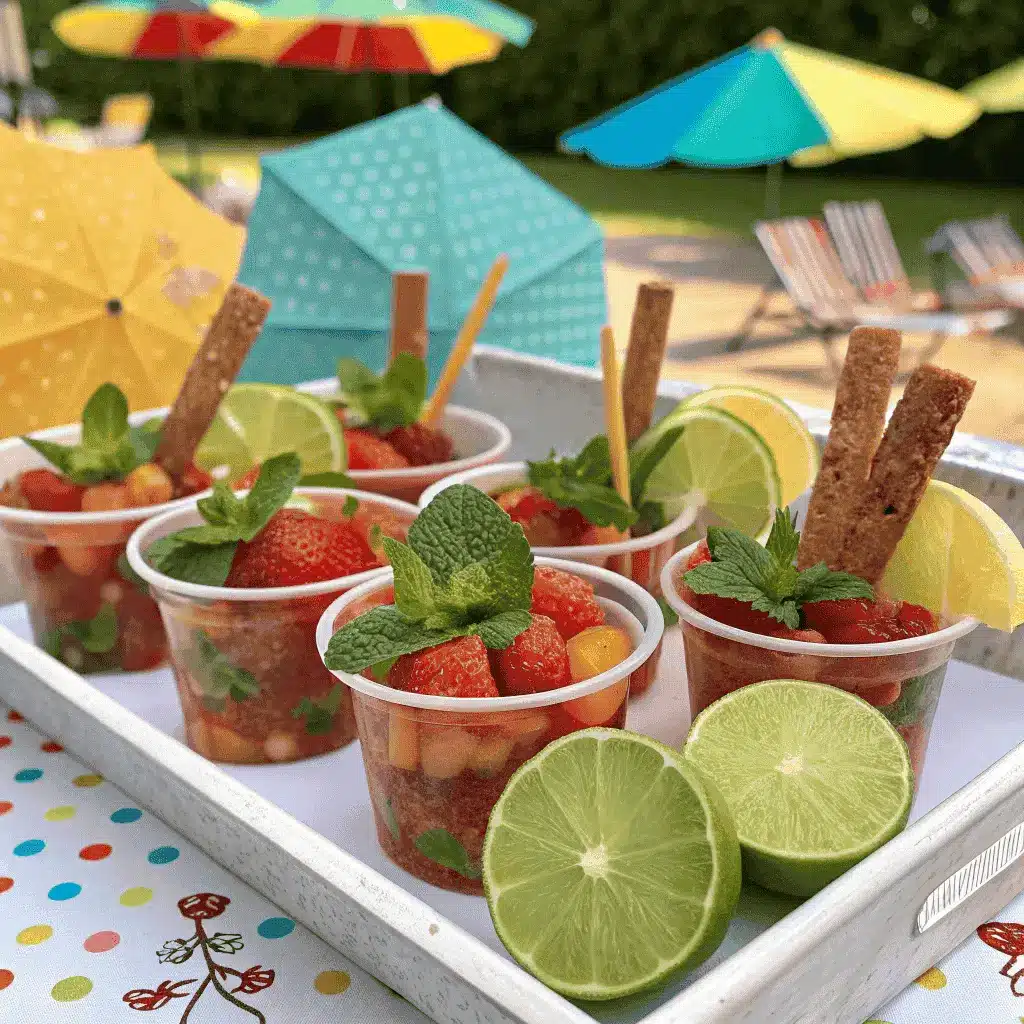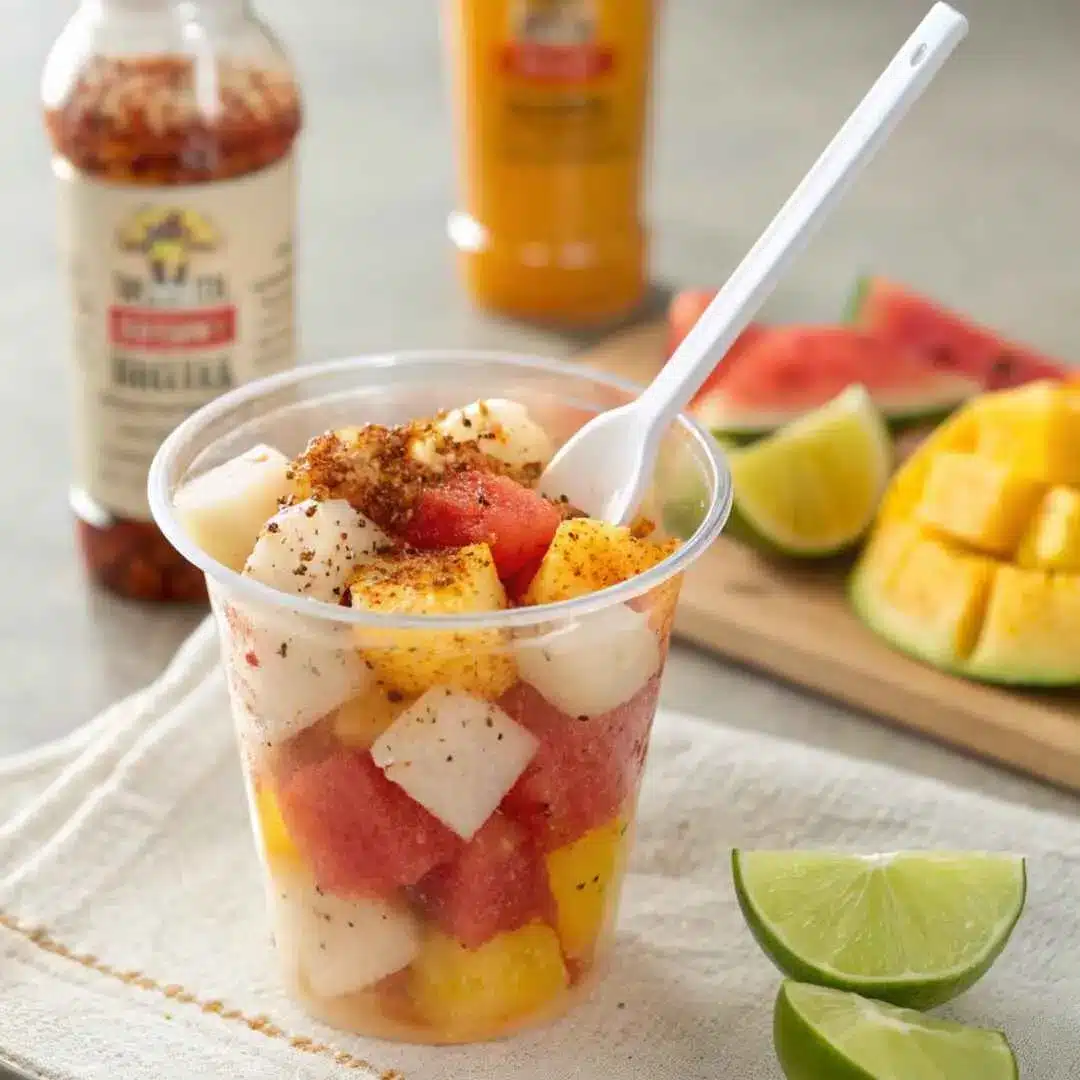A Childhood in Cups of Color
Some kids grew up with ice cream trucks. I grew up with a kitchen full of mangoes, cucumbers, and the steady rhythm of Grandma’s knife tapping against the cutting board. She’d slice fruit into perfect cubes while telling stories about her childhood in Michoacán. On weekends, my mom, tired from work, would join us at the table, and we’d build colorful Mexican fruit cups layer by layer — mango, pineapple, jicama, watermelon. A squeeze of fresh lime would perfume the air, and the chili-lime sprinkle of Tajín made every bite taste like sunshine with a kick.
It wasn’t just about fruit. These cups were a celebration — a rainbow in a plastic cup, cooling us off under the hot afternoon sun. Later, I discovered that street vendors in Mexico made them just the same way, serving them with the same joyful energy. One vendor even sold frozen versions like mangonada, which reminded me of my own twist — my Mangonada Sorbet Bars — proof that the spirit of fruit cups can live in many forms.
Table of Contents
Table of Contents
The Street Food That Brings People Together
In Mexico, fruit cups are more than a snack; they’re a reason to gather. You’ll find them at markets, town plazas, and beaches, often handed to you with a smile and a napkin to catch the chamoy drips. Families linger over them, chatting and laughing, the tangy-sweet scent hanging in the warm air. I love that they adapt to the season — summer calls for juicy watermelon, while cooler months bring in crisp jicama and citrus.
At home, I still make Mexican fruit cups when friends come over. It’s my way of serving up tradition, one colorful layer at a time.
The Fresh & Flavorful Ingredients – What Goes Into a Perfect Cup
Choosing the Best Fruits for Mexican Fruit Cups
The beauty of Mexican fruit cups is that you can customize them to whatever’s fresh and seasonal. Still, some fruits are so iconic to the recipe that they’re almost non-negotiable: ripe mango for sweetness, pineapple for a tropical tang, watermelon for refreshing juiciness, cucumber for a crisp bite, and jicama for its subtle sweetness and crunch. When these are combined, they create the perfect balance of textures and flavors.
For the best flavor, choose fruits at their peak ripeness. Mangoes should have a slight give when pressed, pineapples should smell sweet at the base, and watermelon should feel heavy for its size. Cucumbers and jicama should be firm with no soft spots. In summer, you can mix in cantaloupe or honeydew for extra juiciness, and in cooler months, add orange slices for a citrusy lift.
Just like with raspados (Mexican shaved ice), which I show step-by-step in my Raspados – How to Make Mexican Shaved Ice recipe, the key is starting with the freshest produce possible — because in recipes like this, there’s nowhere for subpar fruit to hide.
The Spicy, Tangy Magic: Chamoy & Tajín
What truly transforms fresh fruit into a Mexican fruit cup is the seasoning. Chamoy is a thick, tangy-sweet sauce made from pickled fruit, chili, and lime. Its combination of salty, sour, sweet, and spicy flavors wakes up every bite. Then there’s Tajín, a chili-lime-salt blend that adds both zing and color. Contrary to what some think, Tajín isn’t a fruit — it’s a seasoning that pairs beautifully with nearly every tropical fruit.
If you love chamoy, you might also enjoy getting adventurous with it, like I do in my Pickle with Chamoy Recipe — proof that chamoy’s possibilities go way beyond fruit.
How to Make Mexican Fruit Cups – Step-by-Step
Prepping the Fruit for Maximum Flavor
The secret to unforgettable Mexican fruit cups starts before you even season the fruit. First, wash all your produce well, especially jicama and cucumber, which can carry dirt in their crevices. Peel mangoes, pineapples, and jicama, then cut them into uniform cubes so every spoonful has a perfect mix. Remove watermelon seeds if needed. Chilling the fruit for at least 30 minutes before assembly keeps it crisp and refreshing.
If you want to add a twist, try pairing mango with a little spice, similar to how I use it in my Spicy Mango Tres Leches Cake — the combination of sweet fruit and chili heat never fails to impress.
Layering for Flavor and Visual Appeal
Step 1: Place a few spoonfuls of your chosen fruits into the bottom of a clear cup. Clear cups make the colorful layers shine.
Step 2: Drizzle a teaspoon of chamoy over the fruit, letting it coat the edges of the cup.
Step 3: Sprinkle Tajín generously over the chamoy layer for that chili-lime punch.
Step 4: Repeat the layers — fruit, chamoy, Tajín — until the cup is full.

Step 5: Finish with a final squeeze of lime juice and a light dusting of extra Tajín on top.
For an extra street-style touch, garnish with a tamarind candy straw or a slice of lime on the rim. The layering not only builds flavor but also creates that signature “rainbow” look that makes Mexican fruit cups so irresistible.
When you take the first bite, the sweetness of the fruit, the tang of chamoy, and the spice of Tajín hit in perfect harmony — the kind of flavor explosion that explains why these cups are a Mexican street food staple.
Serving, Variations & Storage Tips
Fun Serving Ideas for Parties and Gatherings
Mexican fruit cups are as much about presentation as they are about flavor. For casual family afternoons, serve them in sturdy plastic cups with wide spoons. For parties, consider small clear shot glasses for bite-sized portions — they’re easy to grab and look beautiful lined up on a tray. If you’re serving kids, tone down the Tajín and chamoy for a gentler flavor.
Garnishes are where you can have fun: tamarind candy sticks for dipping, lime wedges for squeezing, or fresh mint leaves for a refreshing pop. At street fairs in Mexico, vendors often crown fruit cups with shredded coconut or even a drizzle of sweetened condensed milk, transforming them into something closer to dessert.

Variations & Make-Ahead Tips
The classic combo is mango, pineapple, watermelon, cucumber, and jicama, but you can switch it up depending on the season or your mood. Add papaya for a tropical twist, strawberries for extra sweetness, or even roasted corn kernels for a savory surprise. A sprinkle of roasted peanuts on top adds crunch and protein.
If you want to experiment, mix in fruits that pair especially well with chamoy — like those I use in my Pickle with Chamoy Recipe — and discover new favorites.
For make-ahead prep, cut and chill the fruit up to a day in advance, storing each type in a separate airtight container to keep textures fresh. Assemble the cups just before serving so the chamoy and lime don’t soften the fruit. Leftover seasoned fruit can be stored in the fridge for up to 24 hours, but it’s best enjoyed the same day for peak crunch and flavor.
With a little planning, these vibrant cups can brighten up any table — from backyard cookouts to elegant dinner spreads.
FAQs About Mexican Fruit Cups
What is the Mexican fruit in a cup called?
In Mexico, the general term is vaso de fruta (fruit cup), but depending on the toppings, it can also be called a Bionico when topped with cream and granola, or a mangonada when made with mango, chamoy, and tamarind candy.
What do Mexicans put in fruit cups?
Typical fruits include mango, pineapple, watermelon, cucumber, and jicama. These are seasoned with chamoy, Tajín, lime juice, and sometimes garnished with tamarind candy, coconut, or peanuts.
What fruit is chamoy good for?
Chamoy pairs beautifully with tropical fruits like mango, pineapple, and papaya, as well as refreshing fruits like watermelon and cucumber. It also works surprisingly well with strawberries and oranges.
What fruit is Tajín?
Tajín isn’t a fruit — it’s a seasoning blend made from chili peppers, dehydrated lime juice, and sea salt. It enhances the flavor of fruits, vegetables, and even popcorn.
Conclusion
Mexican fruit cups are proof that simple ingredients can deliver big, bold flavors. They’re sweet, tangy, spicy, and refreshing all at once — the perfect snack to brighten up any day. Whether you enjoy them at a street market or make them at home, each colorful layer carries a taste of tradition and joy. Now it’s your turn to grab a knife, slice up some fruit, and build your own little cup of sunshine.
Print
Mexican Fruit Cups – A Sweet, Tangy Street Treat You’ll Love
- Prep Time: 20 minutes
- Cook Time: 0 minutes
- Total Time: 20 minutes
- Yield: 4 servings 1x
- Category: Snacks
- Method: No-Cook
- Cuisine: Mexican
- Diet: Vegan
Description
Sweet, tangy, and spicy, these Mexican fruit cups combine fresh tropical fruits with chamoy and Tajín for a refreshing street-style snack you can make at home.
Ingredients
2 cups mango, peeled and cubed
2 cups pineapple, peeled and cubed
2 cups watermelon, cubed
1 cup cucumber, peeled and cubed
1 cup jicama, peeled and cubed
1/2 cup chamoy sauce
3 tablespoons Tajín seasoning
2 limes, cut into wedges
Optional garnishes: tamarind candy straws, shredded coconut, mint leaves
Instructions
1. Wash and peel all fruits and cucumber. Remove seeds if needed.
2. Cut mango, pineapple, watermelon, cucumber, and jicama into uniform cubes.
3. Chill prepared fruit for at least 30 minutes for maximum freshness.
4. In a clear cup, add a layer of mixed fruit.
5. Drizzle with chamoy sauce and sprinkle with Tajín.
6. Repeat the fruit, chamoy, and Tajín layers until the cup is full.
7. Finish with a squeeze of fresh lime and your choice of garnishes.
8. Serve immediately and enjoy!
Notes
For milder spice, reduce Tajín or serve it on the side.
You can substitute or add seasonal fruits like strawberries, papaya, or oranges.
Assemble cups just before serving to keep fruit crisp.
Store any leftover fruit in airtight containers in the fridge for up to 24 hours.
Nutrition
- Serving Size: 1 cup
- Calories: 120
- Sugar: 20g
- Sodium: 150mg
- Fat: 0g
- Saturated Fat: 0g
- Unsaturated Fat: 0g
- Trans Fat: 0g
- Carbohydrates: 30g
- Fiber: 4g
- Protein: 2g
- Cholesterol: 0mg

